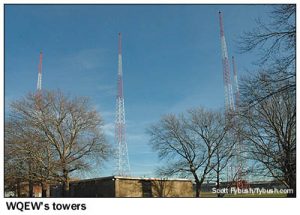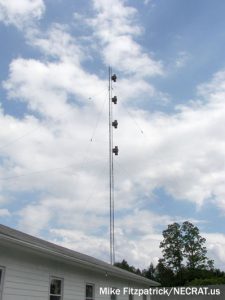NorthEast Radio Watch 3/31/2025: Jim Quinn Signs Off
In this week’s issue… Remembering Pittsburgh's Quinn - Seven Mountains enters Harrisburg - My launches new brands - Ryan out at B101 - More cuts at Radio Vermont - Another AM deleted
In this week’s issue… MA cluster recovers from flood – iHeart’s Boston endgame – What’s next for NYC’s 1560 – Cephas Bowles, RIP – The real story on a Canadian “power increase”
By SCOTT FYBUSH
*With the nonstop pounding of snow that’s been driving MASSACHUSETTS and the rest of New England insane for the last few weeks, it would have been easy to bet that we’d be leading this week’s issue with a story about a studio roof collapsing under several feet of snow, or perhaps ice bringing down a tower somewhere in the region.
 Instead, it’s liquid water leading the column this week, and lots of it, and on Thursday morning all that water was rather unfortunately pouring through the downtown Worcester home of Cumulus’ WXLO (104.5 Worcester), WORC-FM (98.9 Webster) and WWFX (100.1 Southbridge).
Instead, it’s liquid water leading the column this week, and lots of it, and on Thursday morning all that water was rather unfortunately pouring through the downtown Worcester home of Cumulus’ WXLO (104.5 Worcester), WORC-FM (98.9 Webster) and WWFX (100.1 Southbridge).
It appears cold weather was to blame for freezing a six-inch sprinkler pipe that ran through an unheated part of the building. When the pipe burst, station employees said they thought at first that the roof had given way. The bang was actually the pipe bursting, and the noise that followed was an entire stairwell filling with water as it poured down through the seven-story structure. Staffers fled the building as water rose ankle-deep in station offices and studios, and all three stations soon went silent after the power to the building was cut.
The stations were back on the air with automation and generator power by Thursday afternoon, but corporate engineers were soon in the air to assess the damage and figure out a recovery plan. The WXLO main air studio (above) appears to have taken the worst hit, completely soaked by water coming down through the ceiling from upper floors; while it’s likely a total loss, the other studios and offices (and the all-important technical core) mainly had water on the floor and some damage to the walls.
We’ve been writing an awful lot about emergency preparedness lately in this space, and the Cumulus mishap in Worcester is a good reminder of another question any broadcaster needs to be able to answer: if we lose access to our studios, how quickly can we be back on the air – and from where?
[private]
*The week’s other big New England story was covered in a NERW Update early last week (you are on our new email list or following us on Twitter or Facebook, aren’t you?):
 After nine years transmitting from downtown Boston, what’s now WBWL (101.7 Lynn) wants to pack up and move back to its previous transmitter site in Medford, on the hill above the old Malden Hospital. Why reverse course like that? Simple – because unlike the 2006 move that took what was then WFNX from a Medford-sited class A signal to another class A signal downtown, this time the move comes with a substantial power boost to a class B1 signal.
After nine years transmitting from downtown Boston, what’s now WBWL (101.7 Lynn) wants to pack up and move back to its previous transmitter site in Medford, on the hill above the old Malden Hospital. Why reverse course like that? Simple – because unlike the 2006 move that took what was then WFNX from a Medford-sited class A signal to another class A signal downtown, this time the move comes with a substantial power boost to a class B1 signal.
It’s the final chapter of a shuffle we’ve been chronicling from the beginning for our loyal NERW readers, and it helps to explain what iHeart Media had in mind when it started the ball rolling on a big downgrade of co-owned WWBB (101.5 Providence) and a lesser downgrade of WCIB (101.9 Falmouth) on Cape Cod. The latest chapter involves a little more downgrading: WCIB, now a 13 kW/476′ DA signal that’s just barely a class B, will reduce to 12 kW/476′ DA as a class B1, while WWBB will remain technically untouched at its new downtown Providence class A facility, though its allocation coordinates will be modified.
What will it mean for “The Bull,” once it’s all done? Here’s our analysis:
There’s still no beating WBWL’s big country competitor – Greater Media’s WKLB (102.5) enjoys what’s arguably the best commercial FM signal in the entire Boston market, blanketing the country-friendly suburbs from high up on the WBZ-TV tower in Needham with a full class B signal on a nice clear channel. But those country-friendly suburbs will hear a lot more on 101.7 with its new 13.5 kW/452′ signal, instead of the 1.7 kW/449′ the old WFNX signal used at the Medford site or the current 1.7 kW/626′ from downtown.
There’s a tradeoff, of course: if you’re anywhere near the Back Bay or 101.7’s present downtown site, the new 101.7 signal from Medford will suffer overload from all those FMs on the Prudential Tower and the ones that will stay behind when WBWL leaves One Financial Center. That overload wipes out everything on a lot of radios, even powerful signals like WKLB that come from the more distant Needham/Newton sites – and in turn, there’s overload from WKLB and its fellow Needham/Newton signals that will make 101.7 a little iffy along part of Route 128. But 101.7 will become a much more solid signal in the northern suburbs and up toward the Merrimack Valley, and the Malden site will be able to look up and over downtown and the Blue Hills to be at least respectable in Boston’s southern suburbs, too.
(You can see both 101.7 sites, old/new and new/old, at this Tower Site of the Week feature – and I guess we’ll have to make it back to Boston once the snow melts to see the new-new 101.7 site once it’s up!)
*In NEW YORK City, the week’s big news (at least in some circles) came at the top of the AM dial, where Radio Disney’s 16 years on WQEW (1560) came to an end with no fanfare whatsoever Tuesday morning.
 Later in the week, Disney formally closed on its $12.95 million sale of the 50,000-watt signal to Family Stations, which reenters the heart of the New York market two years after selling its longtime home, WFME (94.7 Newark), to Cumulus.
Later in the week, Disney formally closed on its $12.95 million sale of the 50,000-watt signal to Family Stations, which reenters the heart of the New York market two years after selling its longtime home, WFME (94.7 Newark), to Cumulus.
Sometime this week – possibly as early as today, depending on how quickly Family’s engineers can get the work done at the 1560 transmitter site in Maspeth, Queens – the 1560 signal will return to the air with the WFME calls and satellite-fed Family Radio programming from its home base in Oakland, California. Family plans to reintroduce some of the local weather and traffic updates that station manager Charlie Menut used to do on 94.7; it still owns the old WFME studio/transmitter site in New Jersey, and it’s working on an audio feed from there to the new AM signal.
Family will also keep its current FM toehold in northern Westchester, WFME-FM (106.3 Mount Kisco), the little class A signal it got in trade from Cumulus as part of the 94.7 sale.
With the sale of 1560, Disney still has three more AMs to sell off in the region, and there’s no news as yet of any buyers for WMKI (1260 Boston), WWJZ (640 Mount Holly NJ/Philadelphia) or WDDZ (1250 Pittsburgh), which means those signals will remain on the air with satellite-fed Disney programming for now.
At WOR (710), Wayne Randazzo is the new pre- and post-game host for Mets broadcasts this season. Randazzo moves east from CBS Radio’s WSCR (670) and WBBM (780/105.9) in Chicago to fill the role last occupied by Seth Everett.
Out on Long Island, Dave Widmer is out as GM/market manager for Connoisseur’s cluster, where he’d been since 1998 and the days of Barnstable Broadcasting ownership. Widmer helped to oversee the merger of former Clear Channel signals WALK/WALK-FM into the cluster last year, and there’s been no formal announcement yet of a replacement in his longtime post.
“Sunny Joe” Allen has joined Pamal’s Hudson Valley cluster as assistant production director. He’s a familiar name to our New England readers, most recently at Saga’s WKNE (103.7) in Keene, NEW HAMPSHIRE, where he’s been doing afternoons for four years.
It’s been too cold and snowy for much action here in upstate New York, with just a few tidbits from FCC-land: in Buffalo, Family Life Ministries has filed for a license to cover on the move of translator W207BB (89.3 Grand Island) to 106.1, displaced (as we’ll see later in the column) by a new Canadian signal on 89.1. In Oswego, Galaxy has filed for a license to cover on a change of city of license at WTKV (105.5): the “TK” classic rock outlet is now “WTKV Minetto,” which clears the way for Minetto-licensed WKRH (106.5) to move across the Cayuga County line to Fair Haven, allowing it to stay in Galaxy hands without triggering the Syracuse market cap.
And here in Rochester, we were puzzled to see an application for a digital companion channel for W26BZ in nearby Victor; as best anyone here can tell, that station (which relayed MyNetwork affiliate WBGT-CA) has been off the air for many years now. Will the FCC allow it to go digital on RF 22 – and to move to the Hyatt Hotel in downtown Rochester?
 *Sad news from NEW JERSEY, where WBGO (88.3 Newark) announced on Sunday that its longtime CEO Cephas Bowles had died. The Newark native began his broadcast career at Syracuse University in the early 1970s, working at WAER (88.3). He later worked at CBS Radio News and at KUAT in Tucson, Arizona before joining WBGO in 1993.
*Sad news from NEW JERSEY, where WBGO (88.3 Newark) announced on Sunday that its longtime CEO Cephas Bowles had died. The Newark native began his broadcast career at Syracuse University in the early 1970s, working at WAER (88.3). He later worked at CBS Radio News and at KUAT in Tucson, Arizona before joining WBGO in 1993.
At WBGO, Bowles oversaw significant growth, maintaining the station’s independence as one of the few big all-jazz signals in the U.S. and leading a capital campaign that moved its transmitter from downtown Newark to Four Times Square in Manhattan. He was also a major player on the public radio scene nationally, serving for many years on the NPR board of directors.
Bowles retired from WBGO in 2014 while battling serious illness. He died on Saturday; memorial plans hadn’t yet been announced at our deadline.
Some happier news comes from up the road at Fairleigh Dickinson University’s WFDU (89.1 Teaneck), which didn’t waste any time after getting news that the FCC had approved its application to boost power from its transmitter on the historic Armstrong Tower in Alpine. WFDU is raising money to pay for the power boost – and to add new HD Radio services, too: it plans to offer “an expansion of our tried-and-true eclectic music shows that include blues, classic country, oldies, bluegrass etc.” during the week on HD2, while going deep into classic jazz on the weekend. Its HD3 service will be all-classical. (All three services will stream 24/7, even during the weekday hours when the over-the-air 89.1 signal is shared with New York University’s WNYU.)
 *They’ll have to wait for warmer weather to get it built out, of course, but in VERMONT, Christian Ministries’ WFTF (90.5 Rutland) wants to make a big move up to the mountains. WFTF is currently a 720 watt/-561′ class A signal broadcasting from a tower behind the church (shown at right) on Rutland’s north side where it went on the air back in 1987. Now Christian Ministries, which bought the station in 2011, wants to move it up to Pico Peak. From there, WFTF would become a 60 watt/2230′ DA class A signal, sharing a tower with commercial WJEN (105.3 Killington) – and with Christian Ministries’ own 100-watt WGLV (91.7 Woodstock). How would that work out? Pretty well, actually, since WGLV’s directional signal is aimed mainly south and east toward the Connecticut River Valley, while WFTF’s new pattern would be aimed entirely westward down into Rutland.
*They’ll have to wait for warmer weather to get it built out, of course, but in VERMONT, Christian Ministries’ WFTF (90.5 Rutland) wants to make a big move up to the mountains. WFTF is currently a 720 watt/-561′ class A signal broadcasting from a tower behind the church (shown at right) on Rutland’s north side where it went on the air back in 1987. Now Christian Ministries, which bought the station in 2011, wants to move it up to Pico Peak. From there, WFTF would become a 60 watt/2230′ DA class A signal, sharing a tower with commercial WJEN (105.3 Killington) – and with Christian Ministries’ own 100-watt WGLV (91.7 Woodstock). How would that work out? Pretty well, actually, since WGLV’s directional signal is aimed mainly south and east toward the Connecticut River Valley, while WFTF’s new pattern would be aimed entirely westward down into Rutland.
Meanwhile on 90.5 to the east, Green Mountain Educational Fellowship is also applying for a change at its WVFA in Lebanon, N.H.: it hopes to go from its present 12 watts/613′ to 300 watts/613′ from its existing site on Eastman Hill Road southeast of Lebanon.
*One occupational hazard of being a college station is that college building renovations can wreak havoc on your transmitter site. That’s happening in northeast PENNSYLVANIA, where Marywood University’s WVMW (91.7 Scranton) is being forced to move because the college is tearing down the building where it’s now located. WVMW’s proposing a slight eastward move to a different campus location, from which it would run 1.8 kW/-273′ instead of its present 2 kW/-285′ atop the Learning Resources Center on the south side of the campus.
Lindsay Cochrane is the new night host and assistant MD at CBS Radio’s WBZZ (Star 100.7) in Pittsburgh, scooting north up I-79 from her most recent gig in middays at WVAQ (101.9) in Morgantown, W.V.
*It was a week of new station launches in CANADA – and more specifically in southern Ontario, where two new FMs made their official debuts.
 On Friday morning, RB Communications flipped the switch for the formal launch of CKYY (89.1 Welland). “Country 89” had been testing in the Niagara region for several months, and its official start restores country music to an area that hasn’t had a local country signal of its own since the days when sister station CIXL (Giant 91.7) was doing country on the AM dial as CHOW (1470). The new “Country 89” is expected to repatriate some country listening that’s gone west to Hamilton’s CHKX (94.7) or east to Buffalo’s WYRK (106.5).
On Friday morning, RB Communications flipped the switch for the formal launch of CKYY (89.1 Welland). “Country 89” had been testing in the Niagara region for several months, and its official start restores country music to an area that hasn’t had a local country signal of its own since the days when sister station CIXL (Giant 91.7) was doing country on the AM dial as CHOW (1470). The new “Country 89” is expected to repatriate some country listening that’s gone west to Hamilton’s CHKX (94.7) or east to Buffalo’s WYRK (106.5).
Northwest of Toronto in Orangeville, Tuesday was the official launch of My Broadcasting’s latest “My FM” local signal, CKMO (101.5). It’s been testing since November, mostly with Christmas music, and plenty of local officials were on hand at its Mill Street studios for a noontime ribbon-cutting. (And now that Orangeville has a true local station, will this move things forward for Evanov’s application to move Orangeville-licensed CIDC 103.5 closer to Toronto?)
*And we close with one of those stories that is, we hope, why you read NERW each and every week: the real explanation for a story that’s been somewhat mangled in a lot of the trade press this past week.
It involves CKBC (104.9) in Bathurst, New Brunswick, one of the many stations that changed hands from Astral Media to Bell not long ago. As so often happens in a deal like that, the corporate lawyers get busy making sure all the paperwork is just right on their new acquisitions – and in the case of CKBC, they found a discrepancy.
 You may have read elsewhere that CKBC is now raising power because it was operating below its maximum class, or some such. That’s not actually true, and here’s the real story: in Canada, as NERW readers know, there are two agencies that regulate broadcasters, the CRTC (largely for content and competition issues) and Industry Canada (for technical issues). When CKBC was licensed for its move to FM back in 2003, the station originally told both the CRTC and Industry Canada it wanted to operate at 20,000 watts. In September 2003, Industry Canada told the CRTC that it wanted CKBC-FM to run 33,500 watts instead (there’s where that “class maximum” bit comes in), and that was when CKBC was supposed to have filed a revised technical brief with the CRTC specifying 33,500 watts.
You may have read elsewhere that CKBC is now raising power because it was operating below its maximum class, or some such. That’s not actually true, and here’s the real story: in Canada, as NERW readers know, there are two agencies that regulate broadcasters, the CRTC (largely for content and competition issues) and Industry Canada (for technical issues). When CKBC was licensed for its move to FM back in 2003, the station originally told both the CRTC and Industry Canada it wanted to operate at 20,000 watts. In September 2003, Industry Canada told the CRTC that it wanted CKBC-FM to run 33,500 watts instead (there’s where that “class maximum” bit comes in), and that was when CKBC was supposed to have filed a revised technical brief with the CRTC specifying 33,500 watts.
Somehow, that didn’t happen – and so for more than a decade, CKBC has been carried along on the Industry Canada books at 33,500 watts and on the CRTC’s records with 20,000 watts. The Bell lawyers found the discrepancy, and the CRTC has now approved the “power increase,” but it’s all on paper: in the real world, CKBC has been running 33,500 watts since day one, and now it just has the paperwork to prove it.
[/private]

And if you don’t have your Tower Site Calendar, now’s the time!
If you’ve been waiting for the price to come down, it’s now 30 percent off!
This year’s cover is a beauty — the 100,000-watt transmitter of the Voice Of America in Marathon, right in the heart of the Florida Keys. Both the towers and the landscape are gorgeous.
And did you see? Tower Site of the Week is back, featuring this VOA site as it faces an uncertain future.
Other months feature some of our favorite images from years past, including some Canadian stations and several stations celebrating their centennials (buy the calendar to find out which ones!).
We still have a few of our own calendars left – as well as a handful of Radio Historian Calendars – and we are still shipping regularly.
The proceeds from the calendar help sustain the reporting that we do on the broadcast industry here at Fybush Media, so your purchases matter a lot to us here – and if that matters to you, now’s the time to show that support with an order of the Tower Site Calendar. (And we have the Broadcast Historian’s Calendar for 2025, too. Why not order both?)
Visit the Fybush Media Store and place your order now for the new calendar, get a great discount on previous calendars, and check out our selection of books and videos, too!
From the NERW ArchivesYup, we’ve been doing this a long time now, and so we’re digging back into the vaults for a look at what NERW was covering one, five, ten, fifteen and – where available – twenty years ago this week, or thereabouts. Note that the column appeared on an erratic schedule in its earliest years as “New England Radio Watch,” and didn’t go to a regular weekly schedule until 1997. One Year Ago: February 24, 2014 *How fast can a low-power FM station hit the air after getting its construction permit granted? In MASSACHUSETTS, the answer appears to be “wicked fast,” at least if the station in question is WXBJ-LP (94.9 Salisbury). “Good Neighbor Station, Inc.” filed its application on November 12, 2013, had the application accepted for filing on November 25, was granted its CP on February 3, and on Saturday afternoon at 3 the new station hit the airwaves along the New Hampshire border.
*While WXBJ-LP jumped from application to on-air license in just a few months, a full-power CP on Cape Cod is being sold with just a few weeks left before its permit expires. Home Improvement Ministries applied for 89.1 in Brewster in the 2007 window for non-commercial FM applicants and was granted its permit on April 14, 2011. If the station doesn’t get on the air by April 14, 2014, its permit will expire – and that’s why Home Improvement just sold the permit to Boston University’s WBUR (90.9 Boston) for just $7500. WBUR has a project ahead of it: instead of the planned 23 kW/285′ signal (which would actually have been on the Outer Cape, on a new tower near the Eastham-Wellfleet line), it will soon be applying for a more minimal facility to get the signal on the air ahead of the deadline. If it can get its new station built, the new 89.1 will join WBUR’s existing relays on the Cape, WBUA (92.7 Tisbury) from Martha’s Vineyard, serving the lower Cape, and WCCT (90.3 Harwich), the Cape Cod Tech station that carries most of WBUR’s schedule to the mid-Cape. *It appears NEW YORK‘s WOR (710) is headed for a second week of fill-in morning hosts after the abrupt end to its “Elliot in the Morning” simulcast with Washington’s WWDC-FM (101.1).
Five Years Ago: February 22, 2010 When we put this column together over the weekend, we noted (as you’ll read below) that there were “rumors” circulating about a new FM talker in Syracuse – and now they’re rumors no more, as Citadel confirms that it will flip low-rated AC station WLTI (105.9 Syracuse) from “Lite Rock 105.9” to “The Big Talker” next week. The new talk station will feature Indianapolis-based Bob & Tom in morning drive and local talker Gary Nolan in afternoons. (Nolan returns to Syracuse after working in Columbia, Missouri for the last few years.) The rest of 105.9’s program day will be an eclectic mix of syndicated talkers: Stephanie Miller from the left, Michael Smerconish and Dave Ramsey from somewhere in the center and Mark Levin on the right. Next week will bring a new FM talk station to northeastern PENNSYLVANIA, as Bold Gold prepares to relaunch its recently-purchased WLNP (94.3 Carbondale) as “94.3 the Talker,” with a syndicated lineup that includes Don Imus at 6 AM, Glenn Beck at 9, Laura Ingraham at noon, Sean Hannity at 3 and Mark Levin at 6. Will that national slate of hosts get much traction against the largely local lineup over at Entercom’s established WILK network of stations, which goes national for Rush at noon and Michael Savage at 7 PM, but is live and local in morning drive, late mornings and afternoons? We know a little more this week about the lineup on Boston’s new Clear Channel talker, WXKS (1200 Newton), when it launches April 1. In addition to “Coast to Coast AM,” which is already airing on 1200 (now WKOX) and the Premiere-syndicated Glenn Beck and Sean Hannity shows that aren’t currently cleared in Boston, 1200 will also carry the Jason Lewis show (from Clear Channel’s KTLK-FM in Minneapolis) from 6-9 PM, reports the Herald’s Jessica Heslam. She reports that PD Bill George is promising a local morning show, with talent as yet unannounced – and as for that noon-3 PM slot, it’s still widely expected that it will eventually belong to Rush Limbaugh when his contract rights can be pried free from longtime Boston affiliate WRKO (680). As Bill Carroll heads south across the border from CANADA to the U.S. to start his new midday gig at KFI in Los Angeles, CFRB (1010 Toronto) has picked a U.S. talker with Canadian roots to take over Carroll’s 9 AM-noon slot. Jerry Agar, who began his broadcast career in Dauphin, Manitoba, is best known for his recent work in Chicago at WLS and lately at WGN, where he has a weekend shift. He was also heard on WABC for a short stint in 2006-07, doing an evening show for the New York station from Chicago. Ten Years Ago: February 21, 2005 Until now, broadcasting in Port Elgin, Ontario has meant CFPS (1490), the 1000-watt simulcast of Bayshore Broadcasting’s oldies CFOS (560) over in Owen Sound, 20 miles or so to the east. Now the CRTC has approved Bayshore’s application to take CFPS dark, replacing it with a new adult contemporary station on 97.9, with 3800 watts of power and 126 hours a week of local programming for a community that’s had almost none until now. But wait, there’s more: the CRTC also approved a rival application from Brian Cooper and Daniel McCarthy, for a new adult classic hits station with transmitters in Kincardine, Goderich and Port Elgin. The Kincardine signal will be at 95.5 with 5660 watts, while Goderich will operate on 99.7 with 1670 watts. And while Cooper and McCarthy had applied for 97.9 in Port Elgin as well, they’ll have to find a new frequency (though the CRTC approved the application in principle.) In NEW JERSEY, Friday night indeed brought the end of “B-98.5,” WBBO (98.5 Ocean Acres), as Press Communications replaced the hot AC there with modern rock “G Rock Radio,” in a new simulcast with WHTG-FM (106.3 Eatontown). Matt Knight moves over from the old WBBO airstaff to do nights on the new “G.” The FCC grants the addition of 98.9A in Adams, MASSACHUSETTS to the table of allocations – but it’ll be years before the frequency goes up for auction and anything gets built there. The FCC also allots 98.7A to East Harwich, denying competing proposals from John Garabedian to allot 98.7B1 to Nantucket and Monomoy Media for 98.7A at South Chatham. Garabedian tried to argue that East Harwich and South Chatham aren’t “communities” for allotment purposes – and while the FCC bought the argument for South Chatham, it found that East Harwich is listed in the census and worthy of an FM allocation – and so the channel goes to East Harwich. (Again, it’ll be years before anything actually gets built there.) Ed Perry’s not only the owner of WATD (95.9 Marshfield) – he’s also trying to be the defender of journalists’ right to cover stories in the Commonwealth of Massachusetts. Perry was arrested for disorderly conduct, trespassing and resisting arrest back in 2002 for attempting to interview a security guard at the Hanover Mall, and even though the charges were later dropped, he’s suing the mall’s former owner and its security company for violating his civil rights. Perry says the mall owners and the security company have tried to settle with him, but he’s spent more than $20,000 in legal fees in an attempt to prove a point – that reporters should be able to cover stories (a report of a carjacking, in this case) without fear of arrest. The move of WOQL (97.7 Winchendon) to a new tower site across the state line in NEW HAMPSHIRE has cleared the way for channelmate WBOT (97.7 Brockton) to apply for an audacious Boston move-in. The Radio One R&B outlet moved once, a few years ago, from the tower of former sister station WBET (1460 Brockton) to a tower in Abington – but now it’s got enough spacing from WOQL to propose a move to Great Blue Hill in Milton, where the WGBH (89.7 Boston) tower overlooks Boston to the north. WBOT would run 2 kilowatts from 173 meters above average terrain from the Great Blue Hill site (it currently uses 2.7 kW/150 meters from Abington), with a directional antenna putting a null toward Winchendon – but with much better line-of-sight coverage to greater Boston. And it turns out that WBOT’s proposal isn’t even the only audacious Boston move-in on the FCC’s docket, as WFNX (101.7 Lynn) applies to move right into the heart of Boston. Some background here: the former WLYN-FM began on the side of the WLYN (1360) tower in Lynn proper, but for the last couple of decades or so, 101.7 has broadcast from the site above Malden Hospital that was once home to WNAC-TV (Channel 7). That produced a decent signal in the suburbs, but with just 1650 watts at 449′, the 101.7 signal has never done a good job of penetrating the RF haze in the middle of Boston, a problem WFNX tried to rectify a few years ago with the addition of translator W267AI (101.3) on the Hancock tower in the Back Bay. But now WFNX is trying something bigger: it’s applying for a new directional signal with 1690 watts at 627′, high atop One Financial Center, the downtown skyscraper that’s also home to WHRB (95.3 Cambridge) and WERS (88.9 Boston). WFNX’s directional antenna (mounted a few feet above WHRB) would put a pretty deep null towards WCIB (101.9 Falmouth) and WWBB (101.5 Providence), and it would barely cover the city of license (still Lynn!) with the requisite 70 dBu signal. Fifteen Years Ago: February 25, 2000 Two central MASSACHUSETTS radio stations are changing hands, in a set of deals that promise to change the radio dial along Route 2 in a big way. A year and a half after buying WCAT (700 Orange) and WCAT-FM (99.9 Athol), Jeff Shapiro is selling the stations to Citadel for $875,000, a $25,000 profit from his August 1998 purchase price. While the stations sat at the southern arc of Shapiro’s broadcast group in Vermont and New Hampshire (most of which was sold to Vox last year), they’re at the northern end of Citadel’s growing Worcester market, which includes WXLO (104.5 Fitchburg), WORC-FM (98.9 Webster), and WWFX (100.1 Southbridge). WWFX is the interesting piece here; another former Shapiro station, it’s limited from moving its transmitter site northward (and closer to Worcester) by — WCAT-FM! Do we see site moves (or at least a simulcast) on the horizon? As for the AM daytimer: it’s never been much of a player in the market since moving to 700 from 1390 in the 1980s, and now runs mostly Talk America product. Just to the east in Winchendon, WINQ (97.7) is also getting new owners, as Central Broadcasting sells the station to Joe Gallagher’s Aritaur Broadcasting. Aritaur sold its Pittsfield group (WBEC AM-FM, WZEC) to Tele-Media last July, and ironically, Gallagher’s KJI group sold the other 97.7 in Massachusetts, WCAV Brockton (now WBOT), to Radio One last June. There’s no word yet on Aritaur’s plans for WINQ, or on the purchase price. News from NEW YORK: One of the state’s oldest FM stations is getting a new owner. Religious WJIV (101.9 Cherry Valley) passes from Floyd Dykeman to Jon Yinger’s Midwest Broadcasting for $1.3 million. WJIV was one of the old Rural Radio Network/QXR Network/Ivy Network/CBN stations, with a huge coverage over Albany, Utica, and into western New England. It’ll stay religious under Midwest, which also owns religious outlets in Fort Wayne and several Michigan communities, including Detroit’s WLQV (1500, the former twelve-tower directional). From Green to White: A few weeks after unloading his WENY-TV (Channel 36) in Elmira, Howard Green is selling his Elmira radio stations as well. White Broadcasting LLC is the new owner for talker WENY (1230) and AC WENY-FM (92.7); no word yet on price or any format plans. Twenty Years Ago: February 25, 1995 [no issue] |
In this week’s issue… Remembering Pittsburgh's Quinn - Seven Mountains enters Harrisburg - My launches new brands - Ryan out at B101 - More cuts at Radio Vermont - Another AM deleted
Tower Site goes Jeeping (and fixing a flat tire!) up in the mountains of northwest New Jersey
In this week’s issue… New signal for Boston's WJIB - "New Standards" changes stations - New home for Maine FM - Remembering NYC's Diaz, Maine's "Mr. Mike," Albany's McGrath, Rochester's Petschke
A look at two of the Voice of America facilities that were abruptly shuttered this month